This was published 3 years ago
‘I saw death, I saw love’: Artist’s secret testament to life in Iran
When Hadieh Shafie needs to stay focused, she plays music by rap and hip-hop band Run-DMC. The process of rolling paper strips in her studio and pulling them outwards into colourful conic spikes, is pleasingly meditative. It’s when she has to write the intricate mantras on those papers before rolling them that her energy dips. The music prevents her from relaxing.
One of Shafie’s works, Spike 29, will be shown for the first time in Australia at Bendigo Art Gallery this month, in the exhibition SOUL fury – which takes its name from a collection of poetry by 13th century Persian poet Rumi. Sixteen female artists with a connection to Islamic heritage, art and cultures have been brought together in an exhibition that challenges colonialism and the patriarchy.
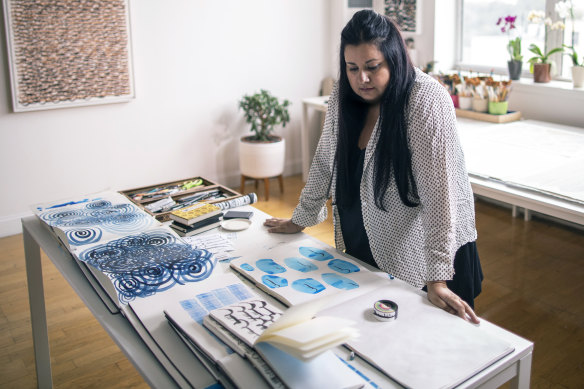
Hadieh Shafie working in her New York studio in 2021. Courtesy of the artist and Yavuz Gallery, Sydney. Credit: Robert J Fagan
When Shafie was a child, her family left Iran to settle in England, but returned in 1978, after the Cultural Revolution. “I could see and feel the change,” she recalls. “When we first arrived I remember my brother grabbing my hand, saying, ‘I think we got off at the wrong station,’ because the country visually did not look the same. There was a sea of women in black chador, and signs in the airport, and we were shocked.
“I saw euphoria, I saw executions, I saw arrests, I saw death, I saw love. And I saw people still making food, sharing food, loving each other. There was this volatile mix of a very heightened series of emotions.”
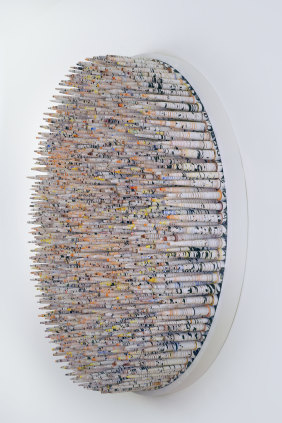
Hadieh Shafie, Spike 29, 2021, paper, acrylic pigment, ink. Courtesy of the artist and Yavuz Gallery, Sydney. Credit: Robert J Fagan
Years later, Shafie, who moved to the United States in 1983, started writing poetry to unpack the experience, eventually just focusing on the word “love”, which she writes inside those curls of paper, hidden to the viewer. As we talk I can see script tattooed on both her forearms. It’s the Farsi word “Eshgh”, roughly translating as “passionate love”.
“Iranians have this habit of sprinkling conversation with poetry,” she says. “At the same time, when they would execute somebody they would say it’s for the ‘love’ of country. I didn’t know what the word love was any more. So by putting it in the curls of paper and holding it dear, it became a mantra.”
Early on in her practice, Shafie wondered if she struck an odd balance, having studied painting at New York’s Pratt Institute and absorbing intellectual material such as Proust’s work about memory, and yet settling to work with paper (she admits to having had a paper fetish since childhood). Such work is often dismissed as craft, which is further stereotyped as a low-art practice that only women do.
“I went through these years in my early 20s thinking: I’m no longer a painter because I’m not using oil paints and canvas … what am I?” she says. “Is this high art or low art?”
The issue of being categorised and misrepresented is a common theme in SOUL fury. The way in which context and meaning can be stolen from art is yet another form of colonial looting, and of course it’s still going on.
Another artist featured in the exhibition, Pakistani-American Shahzia Sikander, has subverted the traditional practice of miniature painting once popular in Persia and the Indian sub-continent – a style considered naive by colonial art collectors more accustomed to European large-scale oils. She is at the forefront of the “neo-miniature” genre, which incorporates contemporary practices and often political themes.
Exhibition curator Nur Shkembi, a scholar of contemporary Islamic art, says Sikander is “making art history, deconstructing and decolonising her work”.
“The way miniature paintings have been framed by Western art historians, it’s taken out of context and presented in a way that becomes really strange and unfamiliar to the people from the culture that it’s come from.”
Shkembri says Sikander and Cambodian-American artist Anida Yoeu Ali often use imagery of veils in their practice to tackle history, colonialism and patriarchy. “The works themselves are aesthetically stunning, but when you start peeling back all the layers and you look at the nuances in the conversations that they’re bringing forward, it becomes a really important document,” she says.
Another featured artist, Shadi Ghadirian, is an Iranian photographer who, in her Qajar series, recreates the elaborate sets of studio portraiture introduced to Iran in the 19th century, and gives the women who pose modern props such as a vacuum cleaner or a Pepsi.
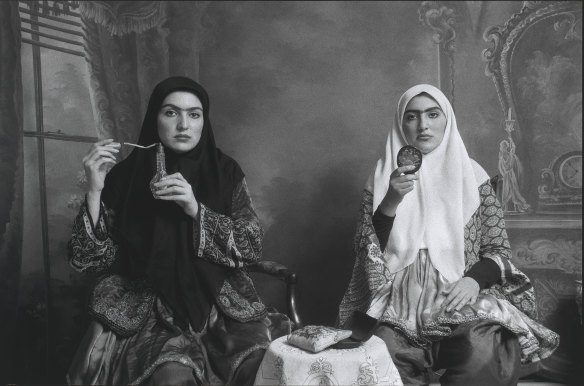
Shadi Ghadirian, Untitled, from the Ghajar series 2000, printed 2007, silver bromide print on paper. Collection of Queensland Art Gallery │ Gallery of Modern Art. © Shadi Ghadirian Credit: QAGOMA
“Sometimes people see this as just the binary between the East and West,” says Shkembi, but Ghadirian’s work is “about the past and the present”.
Nusra Latif Qureshi, who was born in Pakistan but now lives in Melbourne, works with the idea of absence, theft and traumatic loss, distorting and erasing elements of the layers of her work. The Inventory of Noble Causes is a digital print that has been embroidered, with threads and beads drawing attention to certain elements of the images. There’s a photograph of a group of soldiers during the Indian Rebellion of 1857, a couple enjoying wine in the evening, and weapons, almost deformed beyond recognition, from the collection of a British colonialist. Threads from the images dangle into the vitrine below, filled with objects chosen to mock the preciousness of objects in colonial collections.
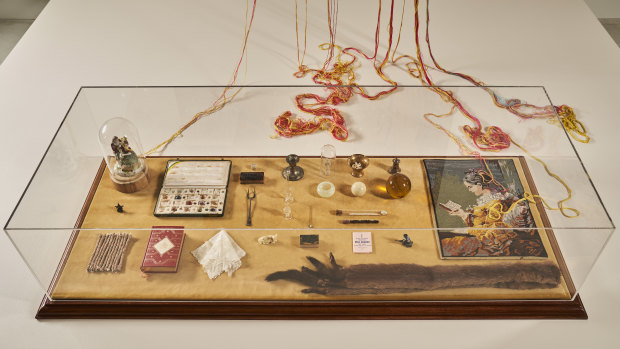
Nusra Latif Qureshi, The Inventory of Noble Causes (detail) 2019, mixed media installation. Courtesy of the artist. Credit: Leon Schoots
“Some are very oblique references to what was considered sacred and what was considered profane, by the colonisers, and the colonised,” Qureshi says.
In Accomplished Missions, a triptych about how men and women see the world, Qureshi plays with the scale of the male and female imagery. The men – playing polo, for instance – get the lion’s share of space. In the corners are tiny silhouettes of women doing post-partum exercises, taken from brochures Qureshi saw in a women’s hospital.
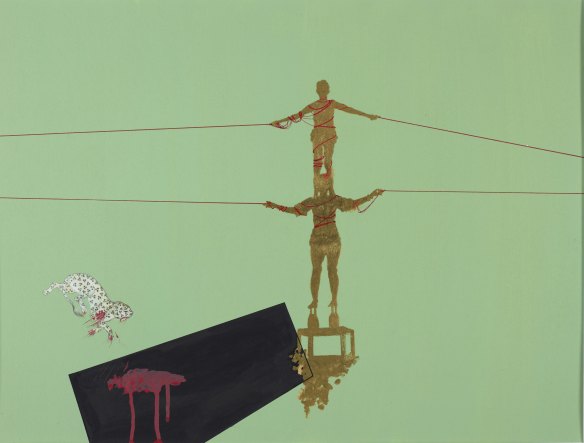
Nusra Latif Qureshi, On the Edges of Darkness II, 2016, acrylic, gouache, gold leaf and ink on illustration board. Collection of Art Gallery of New South Wales. © Nusra Latif QureshiCredit: AGNSW
“Half my audience, statistically, might have seen something like that brochure,” she says. “But how little attention is given to things that can go wrong for women. Men, and their big, political, religious ‘noble causes’, mean there can’t be an end to conflict, because somebody has to sell arms or make money building ships. Women are giving birth to children and trying to teach them not to hit other children, and at the same time are being blamed for their decaying bodies. But they are sustaining life.”
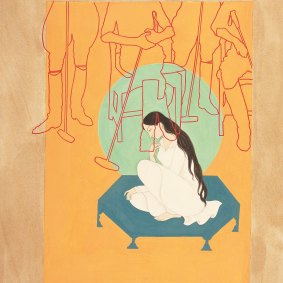
Nusra Latif Qureshi, Justified behavioural sketch 2002, gouache and ink on wasli paper. Collection of Queensland Art Gallery | Gallery of Modern Art. © Nusra Latif Qureshi Credit: QAGOMA
Qureshi moved to Melbourne in 2001 for postgraduate study at the Victoria College of Arts and was surprised that Australia didn’t seem to be a post-colonial society. “I came from … Lahore,” she says. “There, we were constantly in dialogue about what it means to be an ex-colony. In Melbourne there was a smug inaction – everything is fine, we don’t see any problem with having a monarch or lingering ideas of racial superiority or limiting ourselves to American art history … That shocked me.”
Qureshi enjoys hearing about the personal associations that come up when people absorb her work.
“I do cherish those interactions, and sometimes the very interesting, long conversations happen as a result, which is the best outcome. I take away such interesting emotional feedback from that person, and then I learn about their histories, their stories,” she says. “I firmly believe in people’s ability, wherever they come from, to read the visual cues, as they are much less ambiguous than words.”
SOUL fury is at Bendigo Art Gallery until October 24.